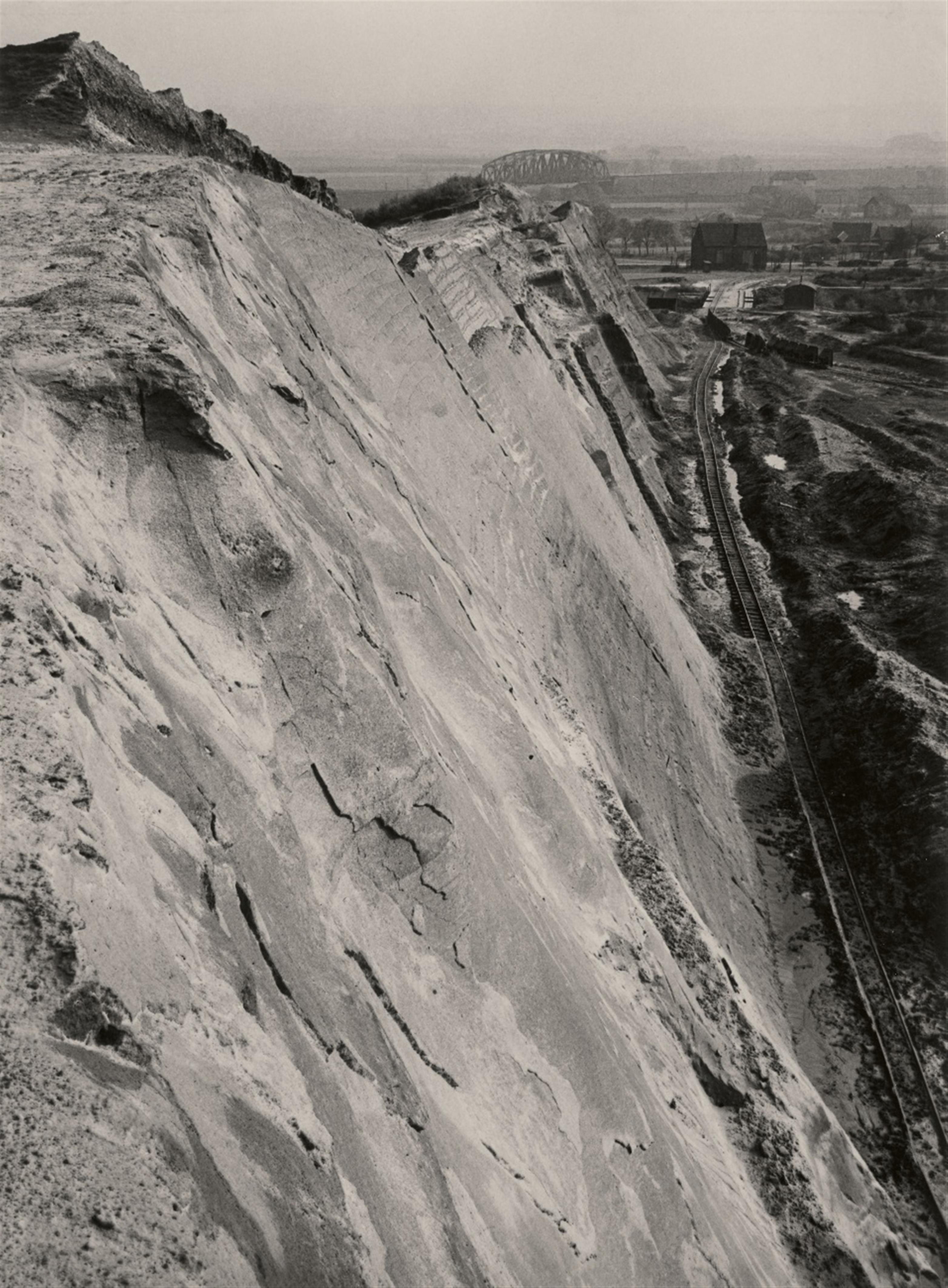Albert Renger-Patzsch
Industrielandschaft bei Essen, Kiesgrube bei Bottrop
1929
Vintage, gelatin silver print on Kodak-Royal paper. 37 x 27.2 cm. Dated in crayon, titled and numbered twice 'I 147' as well as two photographer's stamps on the verso.
From the late 1920s onwards, Albert Renger-Patzsch travelled often through the Ruhr valley due to commissions from the industrial architects Fritz Schupp and Alfred Fischer, whose collieries he documented photographically; in 1929, the year of the creation of Kiesgrube bei Bottrop, he moved to Margarethenhöhe in Essen together with his family. In the years up to 1932, more than 150 free, non-commissioned photographs of this region were taken. However, he did not aim the lens of his camera at places of interest or idylls of nature. On the contrary, it was rather the unattractive places, permeated and scarred by industry that could even be described as dreary - dumps, wasteland, pits, factory chimneys, and shaft towers including smoke, gravel and soil - upon which he focussed. Just as in his object photography, with regards to landscape photography he perceived his role as a photographer in recording their true character in his images: 'So we should see the reproduction of the “landscape as a document” as an obligation that has more appeal to us than the recording of pompous sunsets.' (as cited by Simone Förster, in: Ann und Jürgen Wilde (ed.), loc.cit., p. 11).
At the same time, Renger-Patzsch's own will to create highly aesthetic images manifests itself in his photographs of the Ruhr valley. This applies in particular to the shot of the Kiesgrube. Here, the detail is narrowly chosen; instead of providing a topographical overview, the photographer directs our gaze to the steeply sloping edge of the moulding sand pit, which occupies more than half of the image area. Its surface texture, i.e. the scrape marks as well as the differently discoloured layers of sand, are the focus of photographic interest and condense within the image into a structure of fine lines and grey shades. The rails running below the edge also become a graphic element due to their linearity, the diagonal of which determines the entire composition. Renger-Patzsch does not choose an extreme perspective and does not relinquish the effect of depth in favour of a composition that appears to be purely two-dimensional, as is the case in some of his other photographs. However, here also, the motif is subject to an aesthetic translation in which the various picture planes are combined to form a structure that is independent of the object, finely balanced, and abstractly legible. Renger-Patzsch himself described this procedure in detail: 'The detailed view of the space should be designed in such a way that it results in an ordered picture surface when projected onto the plane.' (as cited by Thomas Janzen, Zwischen der Stadt. Photographien des Ruhrgebiets von Albert Renger-Patzsch, Ostfildern 1996, p. 18). If he succeeds in transforming the real existing location into an aesthetic pictorial space, 'Renger-Patzsch will occupy a significant position in the artistic genre of landscape of the 1920s and 1930s, in addition to his position as one of the most significant object and industrial photographers of New Objectivity. Restrained emotionality and compositional clarity are elements of his objective photographic grammar, according to which he defined the landscapes of the Ruhr in his photographs. In doing so, he succeeded in giving this actually disparate landscape formation an appropriate form within the photographic image. In his images of the Ruhr valley, Renger-Patzsch captured the 'nature of the landscape' in such a manner that this photographic series has an iconic validity beyond its own era with regard to the representation of the region (as cited by Simone Förster, loc.cit, p. 12)
In addition to Drahtzaun im Schnee, Renger-Patzsch's widely published Kiesgrube pertains to the first two photographs that were exhibited in the USA, and that as early as 1932 at 'Philadelphia International Salon of Photography' at Pennsylvania Museum of Art. It is highly probable that the large-format print on light chamois-coloured Kodak Royal paper, which is up for auction here, was the exhibit from that exhibition.
Provenance
Private collection, Rhineland
Literature
Ann und Jürgen Wilde (ed.), Albert Renger-Patzsch. Ruhrgebietslandschaften 1927-1935, exhib.cat. Pinakothek der der Moderne, München, Cologne 2017, plate 79 (here titled: Formsandgrube bei Bottrop); Ann und Jürgen Wilde/Thomas Weski (ed.), Albert Renger-Patzsch. Meisterwerke, exhib.cat. Sprengel Museum Hannover, Munich i.a. 1997, plate 25; Albert Renger-Patzsch 1897-1966, exhib.cat. Jeu de Paume, Paris i.a., Madrid 2017, ill. p. 155; Stefanie Grebe/Heinrich Theodor Grütter (ed.), Albert Renger-Patzsch. Die Ruhrgebietsfotografien, exhib.cat. Stiftung Ruhr Museum, Essen, Cologne 2018, ill. p. 49

